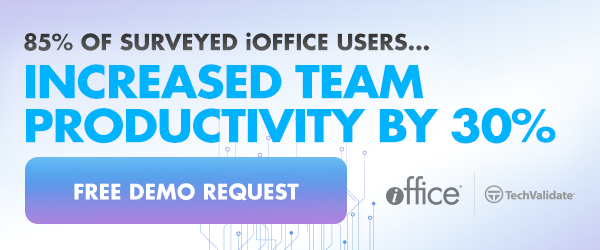7 Poor Working Conditions that Hurt Employee Productivity


Much of the conversation on facility management best practices has centered around reducing real estate costs. While this is certainly a smart strategy, there comes a point when there’s only so much you can cut.
That’s why Kate Lister, president of Global Workplace Analytics, recommends focusing on improvements in employee productivity, which can have an even greater impact on the bottom line. One of the most effective ways to improve employee productivity is by reducing or eliminating poor working conditions.
7 Poor Working Conditions That Hurt Employee Productivity
1) Inadequate Space Utilization
Have you ever heard the term “set up to fail”? If your employees are lacking the space and resources to do their best work, you are doing just that and hindering employee productivity. And it isn’t just about allocating the right amount of space per person. Your employees need enough space to be able to work comfortably, but they also need the right mix of space to be productive. They need to have access to quiet spaces where they can concentrate on deep work, as well as common areas designed for collaboration. And they need an easy way to find and reserve these spaces.
Start improving space utilization now with our guide to gathering workplace intelligence.
2) Ineffective Workplace Technology
Workplace technology is essential for employee productivity and is one of the three most important elements that make up the employee experience, according to author Jacob Morgan.
Technology that’s slow, outdated, or ineffective is frustrating to use and hinder employee productivity. And over time, that frustration can erode employee satisfaction and even push employees out the door.
A survey of 12,000 employees in 12 countries found that 58 percent of employees at companies considered to be “technology laggards” had negative feelings toward their employer.
Inefficient workplace technology hurts employee productivity in a big way. Consider what happens when you’re using outdated software for hosting meetings, for instance. At least a few times a week, you have to restart a conference call, log back in and get everyone back on track.
By eliminating this distraction and others, you give each employee an extra 18 minutes back each day. Multiple that by 500 employees earning an average salary of $85,000, and over the course of the year, this can add as much as $1.6 million back into your annual budget, according to an article Lister published in the January/February issue of Facility Management Journal.
3) Poor Lighting

If there’s one element employees want more than anything else in their workplace design, it’s access to natural light. Poor lighting contributes to eye strain, fatigue and reduced employee productivity. On the contrary, access to plentiful light —especially natural light — can improve productivity.
In a survey by Future Workplace, 70 percent of employees said having access to natural light makes them more productive. Yet more than 33 percent said they felt they had inadequate access to natural light.
4) Inefficient Workplace Processes
Just as it’s critical to evaluate workplace technology, it’s important to take a hard look at your workplace processes and identify opportunities for improvement. Often times, management and employees will accept a process based solely on the assertion that “this is how it’s always been done.”
But times change, and our customers and employees do as well. Open up a dialogue with your team and ask the questions: “What workflow issues are slowing you down?” You’d be surprised at how much things can change with just a few simple tweaks and the automation of certain procedures.
5) A Lack of Workplace Flexibility and Balance
Times have changed a lot since the Baby Boomer generation entered the workforce. The modern workplace isn’t confined to four walls; it goes everywhere with us. In fact, Gallup recently reported that 27 percent of Americans work between 45-59 hours per week, working on commutes or while waiting for dinner to be ready.
Unlike our predecessors, however, a work/life balance is critical. In Gallup’s 2017 State of the Workplace report, 53 percent of employees said a role that allows them to have a greater work/life balance is “very important” to them.
In the same survey, 51 percent of respondents said they would change jobs to have flexible scheduling in their work, yet only 44 percent said their current company offers it. A similar discrepancy exists when respondents were asked about having the option to work off-site at least part time. Thirty-seven percent said they would change jobs for that flexibility, but only 24 percent said their employer offers it.
Recommended: The Agile Work Environment Is Replacing Assigned Seats. Are You Ready?
You can help employees achieve a greater work/life balance by offering flexible arrangements whenever possible. It’s also important to make sure workloads are manageable and encourage employees to use their paid time off.
A well-rested workforce makes a big difference in both the quality and quantity of work.
6) Uncomfortable Working Conditions

It’s difficult to concentrate when you’re shivering or constantly fanning yourself to stay cool. Similarly, issues like broken chairs, wobbly desks or clanging pipes create poor working conditions that can become big distractions.
They keep your employees from engaging in the type of deep work that produces the best results. Over time, they can hurt morale and negatively impact employee productivity and the employee experience.
The good news is that you can easily address this issue by ensuring employees have an easy way to submit service requests via a mobile app.
7) A Toxic Company Culture
Your company culture directly influences employee engagement and employee productivity. In fact, much of today’s workforce will choose to move on to a new job if the workplace culture doesn’t meet their expectations.
Just like a bad attitude, a negative company culture is contagious. It lowers employee engagement and reduces employee productivity.
But there’s more to creating a positive company culture than providing great perks and hosting an occasional happy hour. It starts with your leadership team establishing strong core values and reinforcing them throughout your organization.
How to Supercharge Employee Productivity
If your organization is experiencing erosion of employee productivity and workforce engagement or a higher than normal churn rate, there’s a good chance at least one of these poor working conditions is standing in your way.
While compensation packages are important, the breakdown is likely stemming from something much deeper — more emotional than pecuniary. Yet the impact on the enterprise is almost entirely financial. Not only does the loss of an employee equate to 30 to 50 percent of their annual salary, you stand to lose top talent to your competitors.
Talk with your leadership team and your employees to identify their biggest roadblocks to employee productivity. Once you have a better idea of the problem, you can begin to address it. Here are a few steps to improve poor working conditions and supercharge employee productivity:
- Lead with data. Use space management software and IoT sensors to determine how employees are using the spaces available to them and how you can improve space utilization.
- Be mindful of how you introduce new workplace technology. Look for solutions that integrate with your existing technology platforms, rather than adding to your tech stack. Get feedback from employees to make sure it’s actually going to make them more productive, rather than adding unnecessary steps.
- Give employees flexibility in where, when and how they work whenever possible. Having a remote work policy in place can help.
- Give employees the tools to find what they need to be productive. That includes the ability to find people, reserve space, request service and receive mail or visitors.
In this employee-centric market, your top talent won’t put up with poor working conditions for long. Create the environment they deserve, and you’ll reap the benefits for years to come.

